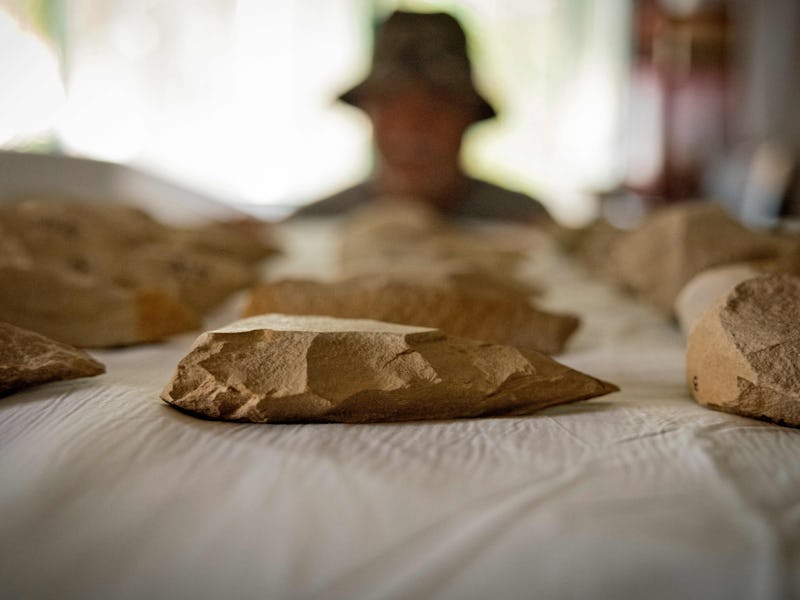An Ancient Hominid Jaw Bone Is Revealing New Clues About Early Human Toolmakers
A new analysis of a fossil unearthed in 1981 reveals clues as to the identity of toolmaking ancient hominids in the Ethiopian highlands.

Far up in the Ethiopian highlands, the resounding strike of stone against stone was probably a familiar one two million years ago. Ancient hominids chipped away to create simple tools: hammerstones with round and jagged edges for hammering and sharp flakes for cutting and scrapping. This earliest known form of tool-making — dubbed Oldowan tools — over a very long period of time lent to more sophisticated Acheulean tools such as highly symmetrical pear-shaped handaxes.
Homo erectus, an early human relative whose fossils have been found in Africa but also across Eurasia, is believed to be the creative mastermind behind the shift. But on the African continent, directly connecting our very late ancestors with the Oldowan or Acheulean stone tool traditions has left archaeologists stumped due to a lack of fossils alongside early tools. However, Ethiopia’s Melka Kunture — a treasure trove of prehistoric World Heritage sites located along the upper Awash River valley — may offer scientists their long-sought answers.
In a study published Thursday in the journal Science, researchers found a Homo erectus infant jaw in Melka Kunture dating back around two million years ago, coinciding with evidence of Oldowan as well as Acheulean toolmaking found at the complex of archeological sites. These findings suggest that, at least in Melka Kunture, Homo erectus both started and perfected the use of stone tools.
Species unknown
The Awash Valley has yielded some of the best-known examples of early hominin fossils, such as one of the oldest known human ancestors, an Australopithecus afarensis nicknamed “Lucy.”
The infant lower jaw was originally found in 1981 in an archaeological site within Melka Kunture called Garba IV, itself first discovered in 1972. This tiny bit of bone was found lying amidst Oldowan stone artifacts, well beneath a layer of Acheulean handaxes, cleavers, and other cutting tools dating back around 1.95 million years ago.
Trying to find out what species the infant was hadn't proved conclusive. Past analyses came back for many different early human species, such as Homo habilis, Homo rudolfensis, Homo ergaster, as well as Homo erectus. There was even some thought the infant suffered from a rare genetic disorder affecting its enamel called amelogenesis imperfecta, but later testing synchrotron imaging — a high intensity and energy X-ray — found that wasn’t the case.
The Homo erectus infant lower jaw bone was first unearthed in 1981.
In a 2016 study published in the American Journal of Biological Anthropology, one group of researchers concluded, based on medical CT scans, that the infant probably shared similarities with Homo habilis, Homo rudolfensis, and, more broadly rather than specifically, Homo erectus.
However, in the new study, researchers pieced together synchrotron imaging with other bits of archaeological data, such as argon-argon dating and magnetostratigraphic analysis, a method used to date rock layers based on changes in the Earth's magnetic field recorded within them. Putting together this tapestry of numbers, the researchers believe the fossilized lower jawbone definitely belongs to a Homo erectus infant who lived and died around two million years ago.
This would place Homo erectus within that period of Oldowan and Acheulean toolmaking and, the researchers say, would also suggest these ancient hominids adapted early and quickly to the high-altitude environment of the Ethiopian highlands some 2,000 meters above sea level.
“The larger-bodied and larger-brained [Homo erectus] was possibly better adapted to the highlands than small-bodied hominins such as Australopithecus and Homo habilis,” the researchers write in their paper.
Adapting to life in the highlands also is what probably led to a shift in more complex tools. Having to learn how to best use the foods and resources local to them, Homo erectus upgraded from simple hammerstones to pear-shaped handaxes to help with foraging and butchering large animals like hippos. The researchers also say it’s possible that Oldowan and Acheulean toolmaking industries co-existed for a period of 300,000 years.
It just comes to show that humanity — ancient or otherwise — is nothing without our tools.